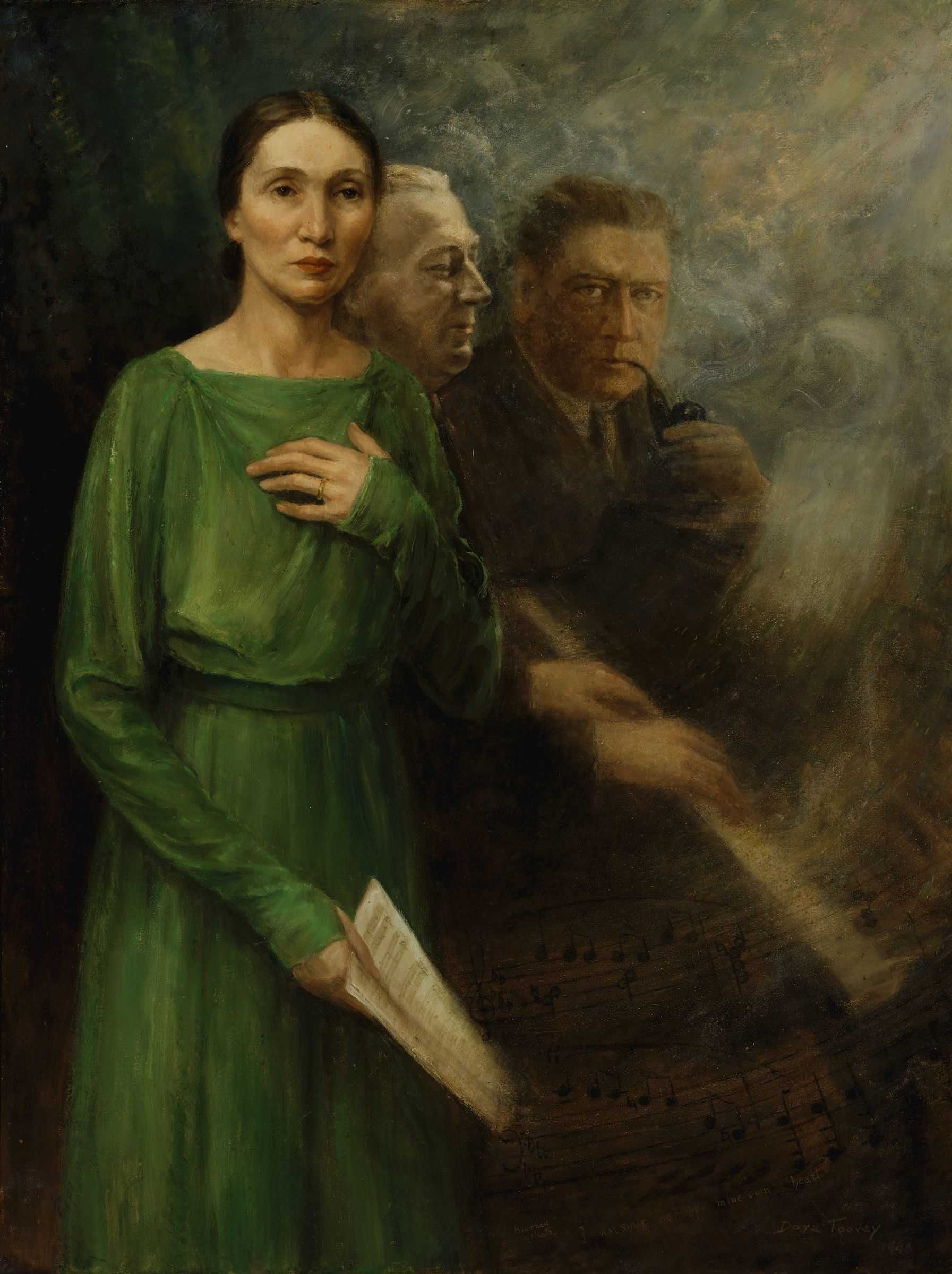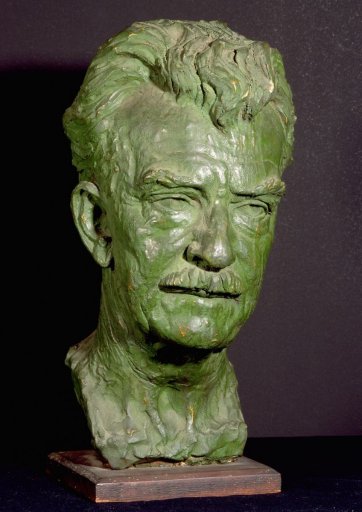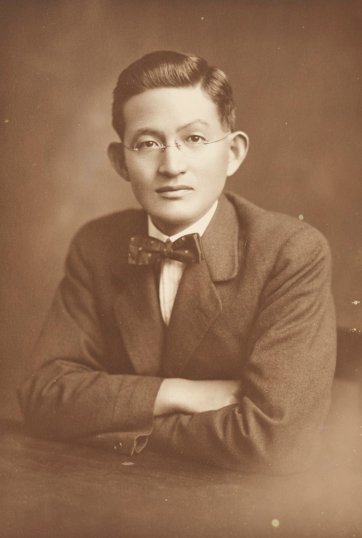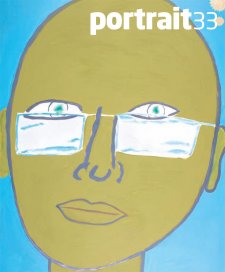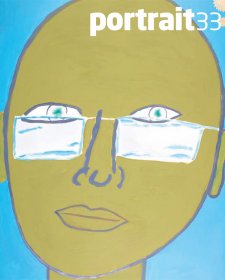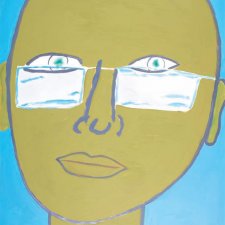The Gallery recently acquired one of few portraits in the collection with a narrative title, Dora Toovey’s Mr and Mrs Horace Keats in the ‘Christopher Brennan Cycle’. It is unusual amongst works in the collection in that it is a triple portrait.
Further, the Gallery does not usually acquire posthumous portraits; but two of the three sitters in this work were deceased at the time it was made – and the artist has rendered the figures in a manner that captures something of their otherworldliness.
The portrait of the musicians Janet and Horace Keats with the spirit of the poet Christopher Brennan is a gift to the Gallery from the subjects’ son, Brennan Keats, and his wife Anne. Brennan and Anne Keats’s publishing house, Wirripang, is a leading Australian independent publisher of fine Australian classical music. Brennan Keats has kept his father’s music alive on compact disc and sheet music, and perpetuated his memory in an evocative, detailed biography, A Poet’s Composer (1997). Horace Keats is further commemorated in a Memorial Scholarship of the Sydney Conservatorium of Music, also a gift of his family.
Janet and Horace Keats are no longer household names, but to early listeners to the ABC they were very familiar indeed. Having trained as a boy at the Brompton Oratory, and worked as a pianist at a roller rink, in concert parties and on oceangoing ships, Horace Keats (1895–1945) came to Australia from his native England in 1915 as accompanist to the American diseuse Nella Webb. After their season together he lingered in Australia, accompanying Peter Dawson, amongst others. He spent three years as orchestral pianist and conductor for various productions by Count Filippini, founder of Australia’s first Italian opera company, and for three years from 1920 he led a trio in the restaurant of Farmers department store in Sydney.
In his early twenties, Horace Keats fell under the spell of a young soprano, Janet le Brun Brown (1900–1985). She was born on her family’s property, Riggsdale, near Goulburn, but on account of frailty she was sent to live with her grandparents, moving around country New South Wales before being sent to various boarding schools. As a girl, she resolved to marry a musician. In turn, after Horace Keats heard Janet sing at the New Zealand Soldiers’ Rest Room in Sydney, he determined to make her his wife. In 1918 he did so – despite implacable opposition from both her family, and his. Through much of their straitened married life they lived at various addresses in Mosman, which was something of an artists’ enclave in the twenties and thirties. Author Ethel Turner lived nearby, as did painter Margaret Preston, cartoonist Livingston Hopkins (‘Hop’ of the Bulletin), sculptor Nelson Illingworth and his son-in-law, the Japanese wool dealer Shigeo Sawada. Cyril Monk, leader of the New South Wales State Orchestra, lived in Raglan Street with his composer wife Varney, next door to Alfred Hill and his composer wife Mirrie.
Born in Melbourne and trained in Leipzig, Alfred Hill was professor of composition, harmony and counterpoint at the New South Wales State Conservatorium from 1916 to 1934. Although there were doubtless times when he felt frustrated in Australia, as a violinist and conductor Hill sensed that around him there were musicians ready ‘to burst into fire’, and as a composer he collaborated with a remarkable variety of individuals here and in New Zealand. Not long after meeting the poet Hugh McCrae on the Mosman ferry, he wrote the ‘light and dainty’ music for McCrae’s fantasia The Ship of Heaven – described in the Sydney Morning Herald as ‘simply a sprightly array of nonsense’ after its one and only performance in 1933. During the first interval, it was reported, ‘the audience was surprised to hear energetic bangings and sounds of rending wood from amongst the orchestral players.
Apparently dissatisfied with the rostrum that had been built for him, Mr Hill had emerged, equipped with a hammer, and proceeded to break the structure in pieces.’ These days regarded as the most significant of the early antipodean composers, Hill had worked with Cyril Monk in New Zealand; Monk, who had studied under the great Kretschmann, had pioneered performances of Hill’s compositions in Australia; and the men played together in the well-regarded Austral Quartet. In Mosman, Keats would join them, with cellists Carl Gotch and Gladstone Bell, to play chamber music on Sunday mornings. In 1938 Hill and Keats both provided music for the Ken Hall film The Broken Melody. The Keats and Monk families remained friends for many years, but Varney Monk once overheard Hill vamping one of Keats’s compositions when he was alone at the piano in his own home. Hill and Keats are commemorated in Alfred Hill Drive and Keats Place in the Canberra suburb of Melba.
Janet le Brun Brown performed under the name of Barbara Russell, but she was always addressed as ‘Mrs Keats’ by the couple’s friends, including Hugh McRae, to whom she was briefly married after Horace Keats’s death. (Keats also maintained his early friendship with Peter Dawson, who helped him build a chook house.) Janet was her husband’s passionate supporter, his critic and guide, over the many years that his musical scores were rejected and accepted by publishers and he wrangled with temperamental musicians in orchestras under his direction. She recalled that often, after completing a song, he would crow ‘I’ve got you this time’, referring to some trap he had laid in the music. He acknowledged, however, that not only was she his constant inspiration, but she had ‘dared the most terrible trials to further the cause of my songs, singing them in the most outlandish places and under trying conditions that would appal ninety-nine per cent of singers.’
Keats worked with Farmers radio station, 2fc, conducting its orchestra from 1924, and the station 2bl from 1925, as an accompanist and leader of various ensembles. (Ron Wylie, who gave the photograph of Shigeo Sawada to the National Portrait Gallery in 2007, recalls his father crying ‘better hurry up or we’ll be 2bl!’ (too bloody late!)). In 1929 the two stations were incorporated into the new Australian Broadcasting Commission. Aside from a couple of brief periods of absence, Keats was involved with the abc as a conductor and accompanist until he died.
From 1933, when Horace Keats began composing in earnest, he wrote more than a hundred rather difficult musical pieces – to this day, his compositions are regularly chosen by singers wishing to prove their ability, in situations such as auditions and eisteddfodau. The only Australian composer to write in whole tone during that period, he recorded a good deal, and his music was often broadcast during his lifetime. In 1934 he began setting the work of Australian poets to music. Two years later, encouraged by Janet, he settled into his series of settings of the poems of Christopher Brennan, who had died in 1932. Although Keats had seen Brennan’s distinctive figure around Sydney, the two men were not acquainted. Nevertheless, on application to the poet’s executors, Keats was granted exclusive rights to deal with Brennan’s poems during his, Keats’s, lifetime. The resulting pieces, which he performed with Janet, came to be regarded as some of Keats’s finest compositions.
Although there are few contemporary Australians who could name one of his poems, Christopher Brennan (1870–1932) is still regarded as one of Australia’s major literary figures. Brennan grew up an Irish catholic in Sydney. Poor but brilliant, he was destined early for the priesthood. Cardinal Moran facilitated a scholarship for him to Riverview; but there, he abandoned his vocation. As a language and classics student at Sydney University Brennan fell in love with Victorian poetry and lost what was left of his religious faith. After a short stint teaching at St Patrick’s in Goulburn, he won a Travelling Scholarship to the University of Berlin, where he became convinced of the power of poetry to reclaim, as it were, an ideal, prelapsarian version of humanity – a romantic notion that was not unusual in sensitive young European agnostics at the time. Brennan wrote: ‘The imaginative act is not, as vulgarly held, the irresponsible creation of unrealities: imagination is a faculty that perceives – outside of the dusty life of outer weariness – the adequacy of our spirit to those only perfect things, the things of beauty; that unites all hints thereof into a perfect life, the only real one because alone worth being real.’
When he came back to Sydney from Europe in 1894, Brennan began work cataloguing in the New South Wales Public Library. There, over a period of thirteen years, he experienced an unmeteoric ascent to the position of second assistant librarian. Not until he was nearly forty was he appointed an assistant lecturer in French and German at the University of Sydney. Brennan’s poetic output – which was complex and symbolic, always more European than Australian in mood – for the most part declined after 1902. Later, he achieved some popular success but his biographer, the late Axel Clark, suggests that the moderately successful pro-war poems he wrote during the First World War sprang essentially from his hostility toward his German wife and her motherin- law. After he divorced, he entered into an affair with a younger woman. Her death as the result of a tram accident gave rise to some of his finest poems, but his life was thrown into irrecoverable chaos. He gained some odds and ends of teaching, and was supported by friends and admirers; he retrieved his Catholic faith before he died.
Brennan was narrowly prized as a cultivated individual at a time when Sydney intellectuals and artists were desperate to maintain some connection with the European and English zeitgeist. Coincidentally, as the National Portrait Gallery acquired Mr and Mrs Horace Keats in the ‘Christopher Brennan Cycle’, a photograph of Henry Lawson was also secured for the collection. It is easy to imagine the embarrassment Lawson’s writing, and Lawson himself, caused the group of Brennan’s admirers – including, for one, the exquisite artist and tastemaker, Thea Proctor. Axel Clark wrote that although Christopher Brennan ‘abhorred Henry Lawson as a poet and a man, the progress of their lives was hauntingly similar: promise, achievement, degeneration, disgrace, posthumous legend.’
This portrait of Horace and Janet is by a friend of theirs, Dora Toovey, who also lived in Mosman. Born in Bathurst, Dora trained in Sydney under Antonio Dattilo-Rubbo, James R Jackson (whom she married) and John Passmore. A painter of portraits from 1924, like many artists of her generation Dora had had a few years’ training in Europe; during three years’ travel studies from 1926 she attended the Académie Julian in Paris, and spent some time under Augustus John in the south of France. She frequently exhibited landscapes in the Wynne Prize, and she was an Archibald finalist thirty-four times although she never won the prize. Mr and Mrs Horace Keats in the ‘Christopher Brennan Cycle’ was her entry for 1945. She painted it six weeks after Horace’s untimely death, by which time Brennan had been dead for thirteen years.
Janet and Horace Keats are depicted lost in their performance, with the spectral figure of Brennan, still smoking beyond the grave, appearing to take an intense interest in the proceedings. There is a look about Horace of one who has ‘crossed the bar’; his son remarks that as far as he recalls, his father never played the piano with his eyes closed. Words and notes from Brennan’s ‘I am shut out of mine own heart’ – the last song the couple ever performed together – drift across the lower edge of the painting. Janet Keats, in the foreground of the portrait, has a faraway, anguished look on her lovely face as she sings the wistful words, fingering the heavy green crêpe of her gown.
This is one of very few portraits in the collection of the National Portrait Gallery that tells a story, and it suggests rather more than it tells. The credit line only adds to the interest it invites – for it has come to the gallery from Brennan Keats, Horace and Janet’s son, whose own name commemorates the association between the trio depicted in the work he has donated.
